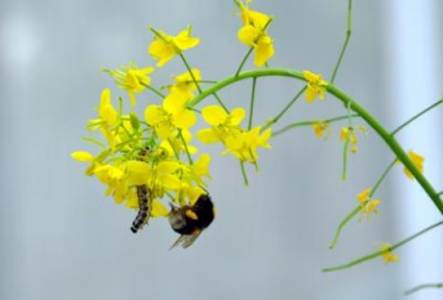植物利用不同的气味吸引或击退昆虫
来源:《New Phytologist》
作者:Florian P. Schiestl等
时间:2014-04-14

This is a turnip rape with pollinating bumblebee and caterpillar
低等植物用花朵的气味和鲜艳的颜色吸引传粉昆虫。如果它们受到如毛毛虫类的草食动物侵扰,则利用叶的气味信号吸引寄生蜂等有益昆虫,然后寄生蜂在毛毛虫身上产卵并杀死宿主。然而,花和叶的香味能相互减少各自的吸引力。这就是为什么开花植物面临两难境地:应该利用自己的资源来吸引传粉昆虫帮助繁殖呢,或是应该投资于防御食草动物呢?
由苏黎世大学Florian Schiestl领导的瑞士-意大利研究小组已证实,植物能够调整它们的气味以满足不同时间的需要,通过这种方式,吸引更有针对性的合作伙伴或益虫。
科学家们研究了芜青遭受草食动物侵袭后的反应,芜青是一种可食用的油菜近亲开花植物。研究人员发现,被侵染植物明显减少了花的气味,以叶气味信号吸引寄生蜂。“减少花香使植物对授粉昆虫的吸引力变小。同时,它对寄生蜂更具吸引力,”这是Florian Schiestl对这种机制的解释。草食动物为害及吸引寄生蜂后,植物产生更多的花来弥补减少的吸引力并吸引传粉昆虫。“因此,花香与其他香味一样在吸引有益昆虫方面起权衡作用”,Florian Schiestl说。
研究结果阐明了植物吸引昆虫伙伴时的重要生态互作关系。Schiestl认为,新的研究结果可能对有用植物的有机栽培有重要的意义。“人们可以设法优化少香味品种对寄生蜂和香味品种对传粉者的吸引力。” (编译:中国科学院成都生物研究所 王芋华,王海燕)
Herbivory and floral signaling: phenotypic plasticity and tradeoffs
between reproduction and indirect defense
Abstract Plant defense against herbivores may compromise attraction of mutualists, yet information remains limited about the mechanisms underlying such signaling tradeoffs. Here, we investigated the effects of foliar herbivory by two herbivore species on defense compounds, floral signaling, pollinator and parasitoid attraction, and seed production. Herbivory generally reduced the quantity of many floral volatile organic compounds VOCs) in Brassica rapa. By contrast, floral color, flower diameter, and plant height remained unaffected. The decreased amounts of floral volatiles led to reduced attractiveness of flowers to pollinators, but increased the attractiveness of herbivore-infested plants to parasitoids. Plants infested with the native butterfly Pieris brassicae produced more flowers during early flowering, effectively compensating for the lower olfactory attractiveness. Herbivory by the invasive Spodoptera littoralis increased the amounts of glucobrassicanapin, and led to delayed flowering. These plants tended to attract fewer pollinators and to produce fewer seeds. Our study indicates a tradeoff between pollinator attraction and indirect defense (parasitoid attraction), which can be mitigated by reduced floral VOC emission and production of more early flowers. We suggest that this compensatory mechanism is specific to plant–herbivore associations with a coevolutionary history.
原文链接:http://onlinelibrary.wiley.com/doi/10.1111/nph.12783/pdf




